NEW YORK — Do not, I repeat, do not set foot in the New-York Historical Society Museum & Library any time between now and April 3 of next year without having lunch first.
The stalwart cultural outpost founded back in 1804 (hence the old-timey hyphen in the name) is the new home to “I’ll Have What She’s Having: The Jewish Deli,” a scrumptious exhibit detailing the history of the great American dining experience. And whether you are a nosher or a fresser, anyone with a taste for knishes, pickled herring, pastrami, or matzoh ball soup will find it impossible to spend more than five minutes in the gallery without getting super hungry.
The exhibit, which originated at Los Angeles’s Skirball Center but has been updated with an eye toward including more from New York City, does a great job of conveying just what differentiates “deli” from all other foods and dining experiences. It emerged from Central and Eastern Europe with the wave of Jewish immigration to North America from 1880 to 1924. Foods from the old country were adapted to the new environment, originally to serve poor people in densely populated neighborhoods. Pushcarts turned into lunch counters, and great neon dining palaces, and as industrialized food production emerged, non-Jewish diners began to recognize that a kosher certificate might not mean anything to them from a religious point of view, but it was often a sought-after mark of quality. (“We answer to a higher authority,” the old ads once went.)
The exhibit takes a bite out of the subject from a number of different angles. There’s the historical, with maps and stats; there’s the etymological, with some quick Yiddish lessons; there’s even some religious training, explaining what differentiates kosher from “kosher style.” You’ll come out of this finally understanding how the word “appetizing” can be a noun as well as an adjective.
But most electric are the artifacts. (Indeed, some are the actual neon signs of great delis of the past.) A bottle of Dr. Brown’s Cel-Ray (“Jewish champagne,” some called it) is something that has long deserved to be under glass in a museum. It is righteous that the old-fashioned cash register from Canter’s in Los Angeles is positioned like a holy relic. (Same with a meat cutter’s smock.)
Get The Times of Israel's Daily Edition by email and never miss our top stories
In addition to the old paper menus (“generous portions of hot corned beef on twin junior rolls served with cole slaw” cost $1.80 at the 2nd Avenue Deli in the late 1960s), there are matchbooks from long-closed delis from across North America. In no way am I nostalgic for the days of ubiquitous cigarette smoke, but when was the last time you saw a branded matchbook?
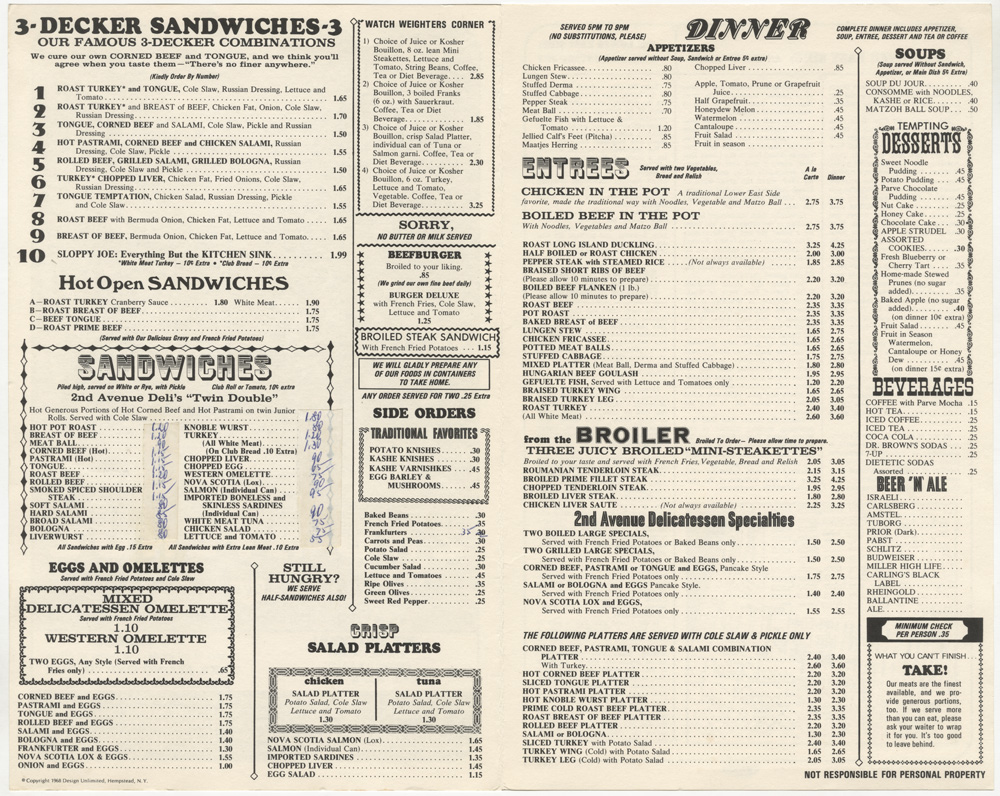
A menu from the 2nd Avenue Delicatessen, New York City, 1968. (Patricia D. Klingenstein Library, New-York Historical Society)
I learned a strange historical footnote at one display — apparently, back in the days of pushcarts on the Lower East Side, pretzels were considered a Jewish delicacy. “The time-honored Jewish pretzel,” they were called. I guess anything ethnic (and German was considered ethnic) was being branded as “Jewish” by some back then. I also loved seeing the old Levy’s rye bread ads from the 1960s (“You don’t have to be Jewish to love Levy’s”), which showed people from all walks of life smiling and chomping down. Though the campaign does rather cavalierly dismiss Jews of color, one photo in the exhibit shows a smiling Malcolm X of all people standing in front of one of the posters.
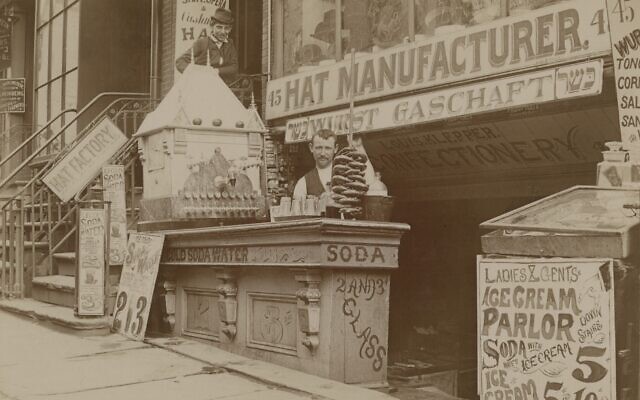
Louis Klepper Confectionary and Sausage Manufacturers at 45 E. Houston Street, circa 1900. (Patricia D. Klingenstein Library. New-York Historical Society)
There’s also attention given to the connection between entertainers hanging out at delis after hours or between shows. (If you’ve never seen Woody Allen’s “Broadway Danny Rose,” filmed at the late Carnegie Deli, you must.) A fun interactive display lets you can build your own sandwich, and then it tells you if it existed as a celebrity-named dish at the (late, but now somewhat revived) Stage Deli. Turns out my creation — corned beef on rye with onion, sauerkraut, and Russian dressing — was the Sammy Cahn. I think I have pretty good taste!
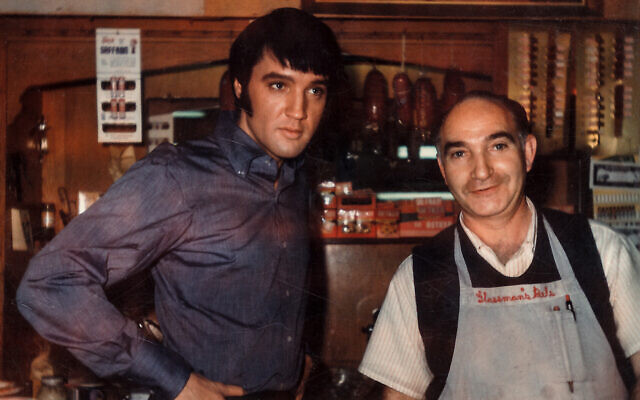
Elvis Presley with deli employee Joe Guss at Glassman’s Deli and Market, Los Angeles, 1969. (From the Bonar
Family Collection/ Skirball Center)
I found myself mesmerized by some of the old photographs, studying faces, trying to eavesdrop on conversations that happened decades before I was born. Some dated back to Jacob Riis and the terrible poverty of the Lower East Side, but as time moved on, portrait artists soon recognized a kind of glamor in these restaurants, particularly at night.
Anyone who has been to Katz’s Delicatessen in New York City (the most famous deli in the world?) knows about their famous World War II-era sign that reads “send a salami to your boy in the army.” Finally, in a respected museum, there’s proof: a letter from a soldier named Benjamin Segan, writing home from Italy, thanking his folks for that gift of cured Katz’s meat.
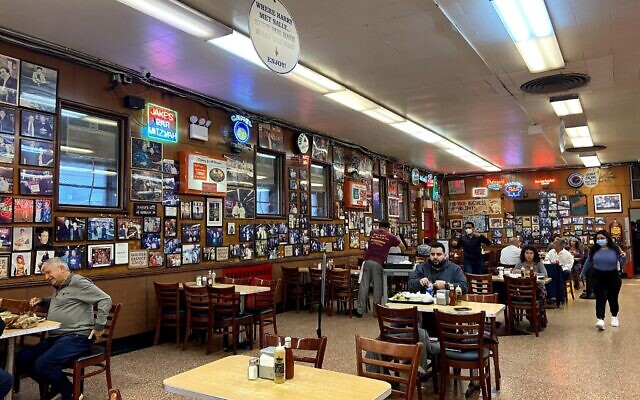
Katz’s Deli in New York City. (Jacob Magid/Times of Israel)
At the press preview I attended, two representatives from Katz’s were on hand — the fifth-generation owner, Jake Dell, and his associate David Manheim, who, through a smile, called himself “the last Jewish waiter.” (I definitely recognized this fella from some of the pictures with celebrities on the location’s hallowed walls.)
Dell gave me a good spiel about what makes Katz’s, and the other remaining “true” delis out there, so special: “The food, the tradition, and the atmosphere.” Of course, at Katz’s, that atmosphere can sometimes be hectic (“Smart!” he said, when I told him I like going there at 4 p.m.), but he called the clamor and chaos “a connection to my history, or, for others, a connection to someone else’s history.” He added that he can feel it at similar celebrated restaurants in other cities outside his culture — like the Cuban restaurant Versailles in Miami or the original Portillo’s sausage spot in Chicago.
Dell and Manheim then got into a minor shouting match when I asked what was the least-ordered food at Katz’s. Bringing up the topic of bologna was controversial for some reason. Interest in tongue and kishka is declining among consumers as time moves on, but kugel and chopped liver sales remain strong. (“We sold 1,200 pounds of it last week.”)
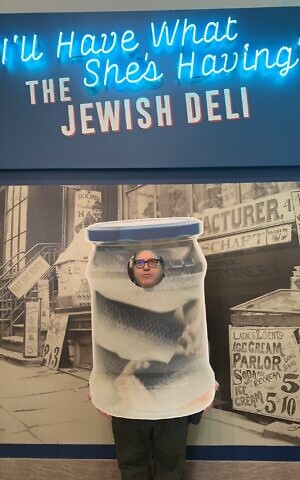
Times of Israel reporter Jordan Hoffman as a jar of pickled herring at the ‘I’ll Have What She’s Having: The Jewish Deli’ exhibition at the New-York Historical Society. (Courtesy)
Katz’s Deli, of course, lends the exhibit its name — it’s the punchline to the famous scene in “When Harry Met Sally,” which was shot there. Indeed, a final section of the show includes a “delis in media” room, with photos and props from film and television, some costumes from “The Marvelous Mrs. Maisel,” and a video screen with clips on a loop. I like the fact that some multigenerational family is going to come visit this and a 12-year-old kid is going to have to watch his grandmother listen to Meg Ryan fake an orgasm.
Alas, part of what makes this a rich show is realizing you’ll need a time machine to truly experience what’s on display. Sure, a few classic locations in New York City and elsewhere are still standing, but the hardcore deli experience — an open door for Jewish culture outside of the context of religion — is pretty much a thing of the past.
Delis, and not just Katz’s, still do exist, but it’s only masquerading as working-class food. A quality pastrami sandwich will set you back big bucks today. (It’s usually worth it.) Enterprising restauranteurs are always getting creative — one such nouveau deli boasts “vegan lox with cashew shmear” and “artisanal pastrami hash in a jar,” whatever the hell that is — and I respect them adapting to modern times. Indeed, that’s what the first delis originally did. But when I go sit in a booth, I want a waitress to yell at me for taking too long to figure out what I want to eat. Do that to someone Instagramming their vegan lox and you’re liable to get sued. Eh, but enough of my complaining. Should we stay for babka and coffee?


